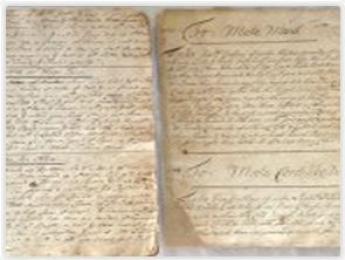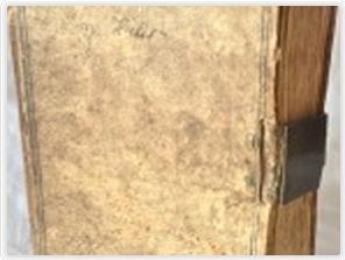The Incredible Treasures of Manuscript Cookbooks

By Kristin Masters
“Now that you have this cookbook, what do you have?”
This question appears on the first page of Julie Anna Kirsh’s family cookbook, in her grandmother’s hand. And it’s a question that at first appears obvious: in a cookbook, you have a collection of recipes, perhaps organized by topic. But in the case of a manuscript cookbook, we can glean so much more insight than merely portions, measures, and cooking time. Manuscript cookbooks offer a glimpse into the daily lives of the women and families who recorded their recipes.
Defining the Manuscript Cookbook
From about 1600 to 1900, the manuscript cookbook was the most common form of recipe keeping. Sometimes also called receipt books or compiled cookbooks, manuscript cookbooks are generally handwritten recipes collected by one person (usually a woman) or a series of people over successive generations. They’re not compiled with an eye for publication, but rather as items of utility. Thus manuscript cookbooks differ from community cookbooks, which were often assembled from the recipes of multiple families as fundraising projects. Manuscript cookbooks come in a variety of forms. They may be simple bundles of paper wrapped with a string or strap, or they may be bound notebooks. Often the way a manuscript cookbook was compiled and/or bound gives further insight into the family who used the book. For example, if recipes were painstakingly squeezed into every available margin, the family might not have been able to afford paper.
What We Learn from Manuscript Cookbooks
Manuscript cookbooks operated as very personalized records of what happened in the kitchen–and other parts of the house. In the study of food history and gastronomy, we can learn much from their pages:
? Substitutions that families may have used to for expensive or scarce ingredients
? Workarounds for time consuming or complicated preparation techniques
? The size, shape, and number of cooking vessels used
? Management of the oven or fire
? Where and from whom a recipe was obtained
? Context in which each dish was served
? How dishes were presented at the table
? Which recipes were best received (eg, family preferences or potluck favorites)
From a broader historical perspective, manuscript cookbooks deliver much more than a glimpse into a family’s culinary habits. They’re an invaluable resource for scholars in a variety of fields.
? Because manuscript cookbooks frequently contain information about where recipes came from, along with contributions from multiple generations, they can provide information about genealogy and relationships among different members of the community.
? These books didn’t contain recipes only used for food preparation; they often include recipes for folk remedies. These entries illuminate daily hygiene, attitudes on disease prevention, and practices for treating illnesses.
? It was common to include recipes for household products like soap and tallow candles. Since these items usually don’t survive the ravages of time, the recipes allow us to replicate them instead.
The beauty of manuscript cookbooks is that each is completely unique. This presents an interesting challenge for both collectors and scholars alike: it makes preservation all the more urgent. If you collect culinary manuscripts or manuscript cookbooks, be sure to work with a trusted, qualified conservator to determine the best way to protect your collection over time.
Further Reading Kirsh, Julie Anna. “Food for Thought: Libraries and Manuscript Cookbooks.” March 2013. University of North Carolina at Greensboro.
(Posted on Lizzyoung Bookseller.com, the blog and website of Elizabeth Young, antiquarian bookseller specializing in anything and everything associated with the wonderful world of food and drink. Presented here by permission of Elizabeth Young and Kristin Masters.)
You are collecting cookbooks? You are going to cook something you never thought you wished to taste?

